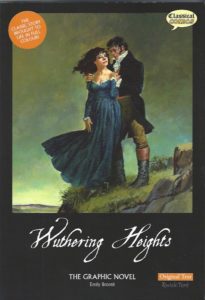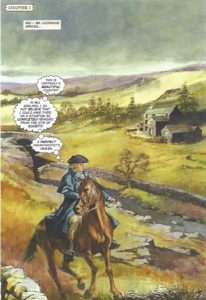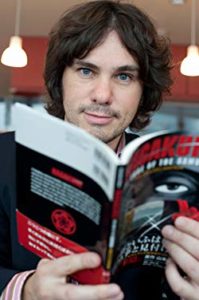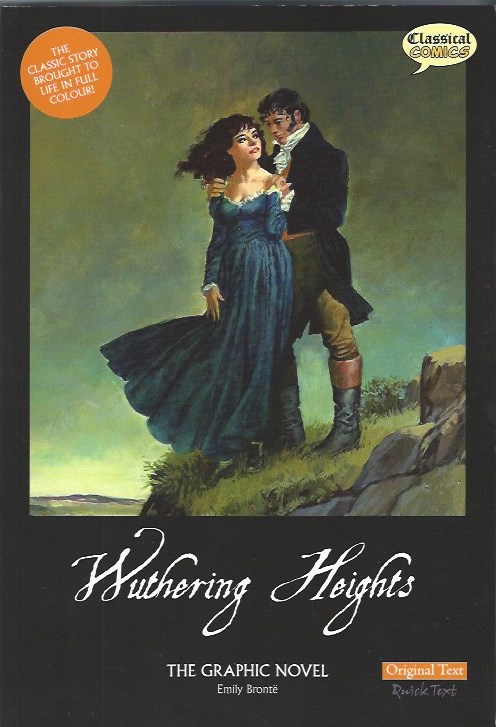
An Interview with Sean Michael Wilson on the creation of the Wuthering Heights graphic novel

BOA: How did the idea for a graphic novel of Wuthering Heights come about?
SEAN: Classical Comics has a well-received line of Shakespeare in comic book format that are geared towards teachers and students in the UK and USA education systems. I wrote 4 adaptations for them of classic 19th Century books: Wuthering Heights, A Centerville Ghost, A Christmas Carol and Sweeney Todd. So they asked me to do Wuthering Heights. The stand out features of these books is their dignified approach. They try to stay close to the original, and stay authentic to the time and language rather than ‘jazzing’ it up or putting it into a modern setting. The quality of art and printing is also very high, with excellent illustrators involved.
BOA: What is the process of putting together a graphic novel like this?
SEAN: Well that would take a whole article in itself! The process of making comic books is more subtle and complex than most realize. In Japan I estimate that about 70% of manga is made by one key person who both writes and draws. In the UK and the USA most books are a collaboration between a writer and an artist. How they work together really does need a whole article to go into. But to put it poetically it’s like a ballroom dance: the two partners create the beauty of the work in the intimate movements, in the flow of the dance.
Essentially there are seven stages in the process of making a comic book/graphic novel: 1. coming up with the initial idea, then trying to persuade a publisher to take it. 2. Writing the plot, synopsis or basic description of characters, aims, place, and the other machanics 3. Writing the script. A comic book script looks a bit like a screenplay. 4. Sketching out the rough art like ‘thumbnails’ 5. More detailed pencil or rough “ink stage” of the art. 6. The finished art, inked or colored – this is what we see on the published book. 7. Lastly, adding the lettering,shading or other final stage visual touches.
BOA: In Wuthering Heights, were there any particularly difficult conundrums?
SEAN: Wuthering Heights had to be cut down from the 330 pages of the original to 140 comic book pages. So the first thing you are thinking is: surely its going to be IMPOSSIBLE to scrap almost 200 pages and yet keep the key plots points in! Well, its not, though it IS difficult. Wuthering Heights has many characters, it takes places over a long time period, plus the unfolding of the drama and relationships are so well integrated that it’s very challenging to reduce anything at all.
But, as a rule, when I am reading through the original novel I am thinking ‘this bit is very important’, or ‘that’s not needed so much’ and I make notes on the book in my own shorthand, marking down VI for Very Important, or S for Skip This? Then, of course, at this first reading I will already have visuals or feelings jump into my head for how something might be done. But the main thing I’m thinking about at this early stage is what to select and what to eliminate. After I have read through the first time I go back and consider the contents of each chapter and make a rough guess of how many comic book pages the chapter can be told in. Then I add up all the chapter page estimates to see how many comic book pages I think the story needs in total. This is partly an intuitive thing you pick up after you have done such adaptations before. It also comes from being a long term comic book reader. I think you start to have a feeling for how something can be paced. Once I start to write the script I have that page breakdown as a guide to how many pages this particular scene should be. I find that I manage to keep to the guide quite well.
BOA What distinguishes Wuthering Heights graphic novel from others you have helped produce?
SEAN: For me the stand out point was working with John M Burns. He is an artist who has been working in the comics since the early 1960s. I first saw his fantastic colour artwork when I was about 8 years old, in a British magazine called Look and Learn. It was very impressive work, especially as back then color was quite rare in British comics. I thought it looked wonderful. John is rightly revered for the quality and skill of his color artwork. So it’s one of the genuine ‘childhood dreams come true’ for me to have done a book with him, all those years later. In my opinion Wuthering Heights is probably the best single collection of color work published in his whole career. I dont say that because I wrote the script, but mainly because the nature of the story allowed John to illustrate some really beautiful scenery and clothing, and dramatic characters, of course!

Sean Michael Wilson is a Harvey and Eisner nominated comic book writer from Scotland, living in Japan. He is the editor of ‘AX:alternative manga‘ (one of Publishers Weekly’s ‘Best ten books of 2010’ and nominated for a Harvey Award) and writer of the Stan Lee Award winning adaptation of ‘Sweeney Todd‘. His book ‘Secrets of the Ninja‘ won a medal in the 10th ‘International Manga Awards’ of the Japanese Ministry of Foreign Affairs – the first British person to receive that award.
Wilson attempts to write comic books that are different from superhero/fantasy brands.

